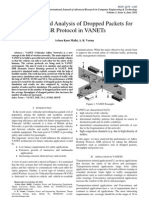"Auto Monitoring of Appliances by Internet": Vivek N. Katare, Pradeep B. Dahikar, S.J. Dhoble
"Auto Monitoring of Appliances by Internet": Vivek N. Katare, Pradeep B. Dahikar, S.J. Dhoble
Uploaded by
Ijarcet JournalCopyright:
Available Formats
"Auto Monitoring of Appliances by Internet": Vivek N. Katare, Pradeep B. Dahikar, S.J. Dhoble
"Auto Monitoring of Appliances by Internet": Vivek N. Katare, Pradeep B. Dahikar, S.J. Dhoble
Uploaded by
Ijarcet JournalOriginal Title
Copyright
Available Formats
Share this document
Did you find this document useful?
Is this content inappropriate?
Copyright:
Available Formats
"Auto Monitoring of Appliances by Internet": Vivek N. Katare, Pradeep B. Dahikar, S.J. Dhoble
"Auto Monitoring of Appliances by Internet": Vivek N. Katare, Pradeep B. Dahikar, S.J. Dhoble
Uploaded by
Ijarcet JournalCopyright:
Available Formats
ISSN: 2278 1323 International Journal of Advanced Research in Computer Engineering & Technology Volume 1, Issue 4, June 2012
AUTO MONITORING OF APPLIANCES BY INTERNET
Vivek N. Katare, Pradeep B. Dahikar 1, S.J. Dhoble2 K.R. Pandav Mahavidyalaya, Nagpur 440009 1 Kamla Nehru College, Nagpur 440009 (M.S.) India 2 Dept. of Physics, RTMNU, Nagpur. Email: - viveknkatare@gmail.com
ABSTRACT
Under the heading it is abbreviated as Networked home appliance system using Bluetooth technology integrating appliance control/monitoring with Internet service Here the monitoring and controlling of home appliances can be done from anywhere with internet facility of service provider via mobile phone or desktop computer and high quality trans receivers and Bluetooth or Zig Bee technology and other wireless technologies. There will be the need of hardware and software components which could be properly composed at the source point and destination for better results by which it establishes atomized scenario. Keywords: Bluetooth; trancreceiverce; embedded system; protocol; hardware; software; Zig Bee.
INTRODUCTION:
Wireless technologies are becoming more and more popular around the world. Consumers appreciate the wireless lifestyle, relieving them of the well known cable chaos that tend to grow under their desk. Nowadays, the world would virtually stop if wireless communication suddenly became unavailable. Both our way of life and the global economy are highly dependent on the flow of information through wireless mediums like television and radio. Cell phones have become highly available during the last decade. [1] New wireless technologies are introduced at an increasing rate. During the last few years the IEEE 802.11 [2] technologies have started to spread rapidly, enabling consumers to set up their own wireless networks. This constitutes an important change in how wireless communications are made available to consumers. Wireless networks are no longer provided by big corporations alone, they can just as well be implemented by individuals. Our society is becoming more and more dependent on wireless communications as new areas of use are introduced. Today, advances in sensors, and microprocessors technology, both on hardware and software level, have enabled distributed implementation of sensor and control actions over sensor/actuators networks. If we connect such local sensors, private networks to global network (internet) additional features could be
exhibit. The monitored and controlled system could become accessible from almost anywhere. The process parameters data display, remote control, system testing and system reconfiguration could be done using standard browsers on workstation computers. That allows us to use large screens, menus, buttons, and online helps, instead of simple alphanumeric displays usually connected to such embedded devices. The bridge between distributed sensors on one side and other side could be embedded web servers. They are low cost devices which allow us to use standards network protocols like TCP/IP and HTTP [3]
STRUCTURE OF CONCEPT:
According to the structure provided in this paper, a person can handle (i.e. monitoring and controlling) of the home appliances by using the facility of internet. The source command provider can give the command to control the appliances at destination. Trough the internet service then get transfer from source to destination via. Internet service provider and WAN. After accepting the command or instruction, a Bluetooth device connected to the machine at destination will work as a transmitter of the signal and due to this the Bluetooth device fixed at the appliance control section will work as receiver simultaneously Monitoring and control system based on simple 1- wire sensor local private network and embedded web servers are presented, detail
182
All Rights Reserved 2012 IJARCET
ISSN: 2278 1323 International Journal of Advanced Research in Computer Engineering & Technology Volume 1, Issue 4, June 2012
description of monitoring and control of the appliances.
DIAGRAM:
9)
10)
11) 12)
STEPS FOR CONNECTION OF BLUETOOTH WITH INTERNET:
1) First, let's open My Network Places by right-clicking in the icon and selecting Properties. 2) We want to change the properties for our connection to the internet. This is the adapter we want to share "from". Just rightclick in the corresponding icon and select Properties. The Bluetooth Network adapter was automatically created during the Bluetooth installation. 3) There's a bug in Windows 2000 before SP3 where changing the sharing option may change IP configurations in this adapter. To make sure you're safe, we will note the current configuration. In the General tab select the Internet Protocol components and click Properties. 4) Write down all the information from the next dialog, and click Cancel. 5) Back in the Adapter properties, select the "Sharing" tab and tick "Enable Internet Connection Sharing for this connection". 6) Now, to configure the Bluetooth USB, rightclick the Bluetooth icon in the system tray and selects Advanced Configuration. 7) Change to the Local Services tab and double click "Network Access". 8) Change the type of service to "Allow other devices to access the Internet/LAN via this computer". The alternative to this option will allow your device to connect to your computer as
13) 14)
15) 16) 17)
18)
19)
part of a LAN, but will not have internet access. Note the Configure Connection Sharing button: it'll open the configuration screens we've visited before. But some Bluetooth software will not have this button; hence I guided you through the other route. Now, on your Pocket PC... Tap the Bluetooth icon the status bar and select Bluetooth Manager. You'll see your notebook or desktop here, and if it's out of range a question mark. Tap the icon corresponding to your computer or notebook. If the computer does not show here, the devices are not paired! Go back and pair then. Tap the Actions menu option. Tap the "Connect to Network Access" option. If all is ok, you'll see the message "Connected for Network Access". Just start using your favorite programs... ICQ, Pocket Outlook, MSN Messenger, Pocket Internet Explorer. If you tap the Bluetooth icon in the status bar again... You'll see the computer or notebook is connected. To disconnect, simply tap the connection icon in the status bar, and tap the Disconnect button. To check your connection from the desktop or notebook, double-click My Bluetooth Places, and open My Device. The icon in green show which Bluetooth profile is in use right now. Right-click My Network Access and select Properties to see its current status.
BLUETOOTH:
The Bluetooth wireless technology is also spreading rapidly. The number of Bluetooth chipset shipped per year has doubled from 2002 to a total of 69 million chipset in 2003 [4]. Bluetooth applications become available, many consumers will already have Bluetooth devices and be ready to start using Bluetooth PANs (Personal Area Networks) where all their Bluetooth devices communicate with one another [5]. Bluetooth is an open standard for short range, low power, and low cost digital radio wireless communication [6]. The Bluetooth
183
All Rights Reserved 2012 IJARCET
ISSN: 2278 1323 International Journal of Advanced Research in Computer Engineering & Technology Volume 1, Issue 4, June 2012
receiver use unlicensed 2.4 GHz frequency band, with a nominal bandwidth of 1MHz for each channel. It offers an effective range of 10 meters (32 feet). Bluetooth can indeed be used in wireless sensors network for short range applications. Bluetooth communication occurs between a master radio and a slave radio. Bluetooth radios are symmetric in that the same device may operate as a master and also the slave. Each radio has a 48-bit unique device address (BD_ADDR) that is fixed. Two or more radio devices together form ad-hoc networks called piconets. All units within a piconet share the same channel. Each piconet has one master device and one or more slaves. There may be up to seven active slaves at a time within a piconet. Thus, each active device within a piconet is identifiable by a 3-bit active device address. Inactive slaves in unconnected modes may continue to reside within the piconet.
they allow different applications to be loaded and peripherals to be connected.
EMBEDDED WEB SYSTEM DESIGN:
SERVERS
ZIG BEE
Zigbee is a relatively new, wireless personal are network technology based on IEEE 802.15.4, with a transmission range of 100+ meters [7]. ZigBee based communication devices consume very little power and hence the battery life of 1000+ days is common. ZigBee has enormous advantages compared to Bluetooth when used in wireless sensor networks. The reason includes more coverage area, less power consumption, and secure networking. ZigBee operates in the industrial, scientific and medical radio bands 868 MHz in Europe, 915 MHz in the USA and 2.4 GHz in most other countries in the rest of the world.
EMBEDDED SYSTEMS:
An embedded system is a specialpurpose computer system designed to perform one or a few dedicated functions, often with real-time computing constraints. It is usually embedded as part of a complete device including hardware and mechanical parts. In general, "embedded system" is not an exactly defined term, as many systems have some element of programmability. For example, Handheld computers share some elements with embedded systems such as the operating systems and microprocessors which power them but are not truly embedded systems, because
Embedded system requires web server software that enhances their networking functionality without taking up vital system resources. Web enabling of devices is possible by adding web server software to existing embedded system. Requirements for embedded web servers are: Small memory footprint: server must use very little memory and it must not fragment memory. Many embedded devices use simple memory allocators that cannot manage memory effectively. This problem is usually solved by using statically allocate or preallocated memory blocks. Dynamic age generation: since the content of the pages served will be status information and Bluetooth reading part or all of the web pages will have to be generated on the fly. Reducing embedded web server capabilities to minimal set of necessary functions makes hardware requirements as well as energy consumption very small. Therefore dimensions and the price of the device are miniatures compared to the desktop PC with full functionality preserved at the same time. a) Protocols: Although TCP/IP (Transmission Control Protocol/Internet Protocol) is the main communication protocol that enables connection of different devices in networks, it is not implemented in full. Only the necessary parts are used and parts that are not needed for this sort of communication are excluded. Furthermore, TCP/IP protocol is basis for upper level network protocols which will be used in embedded systems. If the system uses RS-232C or modem link then point to point (PPP) or serial line internet protocol (SLIP) is needed. File transfer protocol (FTP) is used for uploading new files and programs to the system. Opposite to the receiver driven information go through web browser, information flow could device driven. Using simple mail transfer protocol (SMTP) application can periodically send information via email. b) Software: A minimal set of software for embedded internet system includes an operating system and
184
All Rights Reserved 2012 IJARCET
ISSN: 2278 1323 International Journal of Advanced Research in Computer Engineering & Technology Volume 1, Issue 4, June 2012
application software, an http server, a TCP/IP stack, and drivers for communication hardware. The use of internet allows the embedded system to offer substantial online capabilities without using system resources. With HTML pages pointing to other network locations, the system can offer more online documentation and richer graphics than the system hardware could otherwise support. In addition, supplying the raw data to more powerful partner on the network and presenting the results of partner calculations can virtually increase the system processing power. As we can see with clever programming and the use of internet, systems capabilities can be virtually increased to a higher level. The presence of embedd3d web server must not obstruct the systems primary real time operation in any way and therefore system response, must be compromised to main function. The internet software should not be the limiting factor for the speed of data flow between the server and the browser. The HTML pages should not be burdened with extensive graphics. The presence too many graphical elements consume much more memory than text and therefore take much more time to download to browser. The page down load time should be acceptable for the user, not longer than couple of seconds. [8] c) Hardware: Hardware requirement result from the given selection of requirements and set of software to resolve those requirements. The minimal set up for network enabling of embedded systems includes 8 bit microprocessor, Ethernet and/or serial interface and enough memory to store and run applications. No I/O devices are needed since all these operations are managed through internet. Further system improvements depend on desired system price and capabilities. These 8 bit devices can address up to 16 MB memory and often include hardware accelerated interpreters for high level language, which make them adequate for this purpose. Memory storage device such as hard disk device are defiantly optional and most of these devices will run software directly out of ROM or flash instated of loading it into RAM memory. This enables the system to boot in just a second or two as opposed to the minutes that a desktop Windows system can take.
Results: The connectivity between two internet terminals has been made by using the network service provided by the internet service provider. The compatibility between devices connected to both i.e. destination computer system and control circuit of appliances, has been made effective by using JAVA computer software language Conclusion: After connectivity, the home appliances can be easily monitored by using Bluetooth and high quality trancreceiverce embedded system. But in future it can be further modified and make faster by using Zig Bee technology.
REFFERENCES:
[1]:Subhas C. Mukhopadhyay, Anuroup Gaddam and Gourab S. Gupta, Wireless sensors for Home Monitoring, College of Science, Massey University, Palmerston North, New Zeland, Recent Patents on Electrical Engineering 2008, 1. [2]: M.S. Gast, 802.11 Wireless Networks, First Edition, OReilly, 2002. [3]: Darko Stipanieev, Member IEEE, Maja Eiac and Jadrenka Marasoviae, Member IEEE. Networked Embedded Greenhouse Monitoring and Control. [4]:See http://www.mobilemag.com/content/100/10 4/C2783. [5]:D.Gratton, Bluetooth Profiles, The Definitive Guide, First Edition, Prentice Hall, 2003. [6]: http://www.bluetooth.com/bluetooth/ [7]: See: www.Zigbee.com [8]: R.A. Quinnell: Web servers in embedded system enhance user interaction, EDN Magazine, April 10, 1997.
185
All Rights Reserved 2012 IJARCET
You might also like
- Computer Networking: The Complete Beginner's Guide to Learning the Basics of Network Security, Computer Architecture, Wireless Technology and Communications Systems (Including Cisco, CCENT, and CCNA)From EverandComputer Networking: The Complete Beginner's Guide to Learning the Basics of Network Security, Computer Architecture, Wireless Technology and Communications Systems (Including Cisco, CCENT, and CCNA)Rating: 3.5 out of 5 stars3.5/5 (5)
- Cache Size Vs Block Size 2.2.3Document12 pagesCache Size Vs Block Size 2.2.3Arjun Nain100% (1)
- Embedded IoT Assignment Answers TemplateDocument5 pagesEmbedded IoT Assignment Answers TemplateMuhannad TahaNo ratings yet
- How To Update SoftwareDocument4 pagesHow To Update SoftwareNayarit TianguisNo ratings yet
- BATCH-C Nidhi Boriwar HomeworkDocument63 pagesBATCH-C Nidhi Boriwar HomeworkJARVISNo ratings yet
- ThesisDocument8 pagesThesishalasilili99No ratings yet
- Bluetooth Based Smart Sensor Networks 2012Document14 pagesBluetooth Based Smart Sensor Networks 2012Vijay BavikattiNo ratings yet
- Devansh IOT Exp 1-MergedDocument24 pagesDevansh IOT Exp 1-MergedsourabhediterNo ratings yet
- Definition of IOTDocument4 pagesDefinition of IOTParmi ModiNo ratings yet
- Bluetooth Based Smart Sensor Networks: Student Name:Fatemah Mohammad Student ID:201510720Document10 pagesBluetooth Based Smart Sensor Networks: Student Name:Fatemah Mohammad Student ID:201510720Manal FaluojiNo ratings yet
- IoT Technologies and ProtocolsDocument13 pagesIoT Technologies and Protocolsshalivahana naveen kumarNo ratings yet
- Unit 1-I B.Tech (IoT)Document15 pagesUnit 1-I B.Tech (IoT)Maitrayee SuleNo ratings yet
- V3i409 PDFDocument3 pagesV3i409 PDFIJCERT PUBLICATIONSNo ratings yet
- Problem Statement: Case Study: Cold Chain StorageDocument20 pagesProblem Statement: Case Study: Cold Chain StorageGaurav SharmaNo ratings yet
- ManetDocument8 pagesManetunofficialokkNo ratings yet
- Bluetooth Based Smart Sensor Networks: Student Name: Student IDDocument8 pagesBluetooth Based Smart Sensor Networks: Student Name: Student IDlamNo ratings yet
- Home Automation IOTDocument4 pagesHome Automation IOTMurtazaNo ratings yet
- Chapter One: Real Time Android Application (Text) Through Socket Using Bluetooth Technology Page 1Document56 pagesChapter One: Real Time Android Application (Text) Through Socket Using Bluetooth Technology Page 1student wwNo ratings yet
- Home Automation Using IoTDocument11 pagesHome Automation Using IoTIJRASETPublicationsNo ratings yet
- Bluetooth Based Home Automation SystemDocument10 pagesBluetooth Based Home Automation Systempra09deepNo ratings yet
- Chapter One: Real Time Android Application (Text) Through Socket Using Bluetooth Technologypage 1Document56 pagesChapter One: Real Time Android Application (Text) Through Socket Using Bluetooth Technologypage 1Chakravarthi rocksNo ratings yet
- BluetoothDocument6 pagesBluetoothLekha DesuNo ratings yet
- Synopsis: Bluetooth MessengerDocument12 pagesSynopsis: Bluetooth Messengerapi-3701758No ratings yet
- Bluetooth PiconetDocument25 pagesBluetooth PiconetAbhishek SkNo ratings yet
- Iot Lab FileDocument22 pagesIot Lab FileSarthak BansalNo ratings yet
- 78#bluetooth Based Smart Sensor Networks Sree Man ColDocument24 pages78#bluetooth Based Smart Sensor Networks Sree Man ColPraveen Puthuparambil0% (1)
- Bluetooth TechnologyDocument13 pagesBluetooth TechnologyParthasarathi AnbalaganNo ratings yet
- Iot Unit1Document41 pagesIot Unit1Apoorv GanavdiyaNo ratings yet
- Project On Bluetooth Technology: Presented ByDocument9 pagesProject On Bluetooth Technology: Presented BySanjeev Kumar SahuNo ratings yet
- Naresh SeminarDocument9 pagesNaresh Seminarluckypratap06No ratings yet
- Bluetooth Based Smart Sensor NetworkDocument32 pagesBluetooth Based Smart Sensor NetworkshantanitikaleNo ratings yet
- SHARES Technical Notes (July 2000)Document9 pagesSHARES Technical Notes (July 2000)Edy Siswanto HsNo ratings yet
- Pocketdrive: A System For Mobile Control of Desktop PC and ItsDocument6 pagesPocketdrive: A System For Mobile Control of Desktop PC and ItsSiddharth GhodkeNo ratings yet
- Bluetooth Technology: E-Mail: Prakasamengineeringcollege@yahoo - Co.inDocument12 pagesBluetooth Technology: E-Mail: Prakasamengineeringcollege@yahoo - Co.indumbijoalNo ratings yet
- Iot Complete NotesDocument109 pagesIot Complete NotesMitali VishwakarmaNo ratings yet
- Application of Real Time Operating System in The Internet of ThingsDocument6 pagesApplication of Real Time Operating System in The Internet of Thingspatelhiren3385No ratings yet
- M-1 - IOT - Definition & Characteristics - Physical Design of IoTDocument7 pagesM-1 - IOT - Definition & Characteristics - Physical Design of IoTPinaki BoseNo ratings yet
- Bluetooth Based Smart Sensor NetworkDocument32 pagesBluetooth Based Smart Sensor Networkjitendrakmr59380% (5)
- (IJCST-V5I2P71) :prof. Prashant Rathod, Syed Khizaruddin, Rashmi Kotian, Shubham LalDocument6 pages(IJCST-V5I2P71) :prof. Prashant Rathod, Syed Khizaruddin, Rashmi Kotian, Shubham LalEighthSenseGroupNo ratings yet
- DCC MicroprojectDocument7 pagesDCC MicroprojectAbhishek GayakwadNo ratings yet
- Introduction To Internet of Things (Iot)Document97 pagesIntroduction To Internet of Things (Iot)bijalrana173No ratings yet
- Internet of Things Module 1 and 2Document28 pagesInternet of Things Module 1 and 2varun thakurNo ratings yet
- Bluetooth Based Smart Sensor NetworkDocument30 pagesBluetooth Based Smart Sensor NetworkSushant SharmaNo ratings yet
- IOT CharacteristicsDocument31 pagesIOT Characteristicsnandutripathi138No ratings yet
- Smart Home Automation Using AndroidDocument8 pagesSmart Home Automation Using Androidultimatekp144100% (1)
- IoT BASED SMART HOUSE and SHORT CIRCUITDocument3 pagesIoT BASED SMART HOUSE and SHORT CIRCUITfiyoviw911No ratings yet
- IOT Based Smart Home With Load ControlDocument8 pagesIOT Based Smart Home With Load ControlIJRASETPublicationsNo ratings yet
- Unit - IDocument21 pagesUnit - IDhurvesh HingnekarNo ratings yet
- Iot NotesDocument5 pagesIot NotesUdhaya KumarNo ratings yet
- Bluetooth Based Home AutomationDocument17 pagesBluetooth Based Home AutomationShruthiNayerNo ratings yet
- Iot Unit NotesDocument13 pagesIot Unit Noteskei40013No ratings yet
- Zigbee Vs BluetoorhDocument7 pagesZigbee Vs BluetoorhMehulLathiyaNo ratings yet
- Bluetoothtechnology: Seminor OnDocument9 pagesBluetoothtechnology: Seminor OnNitturi VinodkumarNo ratings yet
- BluetoothDocument13 pagesBluetoothManikandan MurugesanNo ratings yet
- Bluetooth Remote Controller Using JAVADocument27 pagesBluetooth Remote Controller Using JAVAJack PaneNo ratings yet
- Comparison of Internet of Things (Iot) Data Link Protocols: AbstractDocument21 pagesComparison of Internet of Things (Iot) Data Link Protocols: AbstractMoody KatNo ratings yet
- Bluetooth Based Wireless Sensor NetworksDocument50 pagesBluetooth Based Wireless Sensor NetworksDegusa PatelNo ratings yet
- Internet of Things A Hands - On Approach - Arshdeep Bahga, Vijay MadisettiDocument34 pagesInternet of Things A Hands - On Approach - Arshdeep Bahga, Vijay MadisettiFeroza MirajkarNo ratings yet
- Building the Internet of Things with IPv6 and MIPv6: The Evolving World of M2M CommunicationsFrom EverandBuilding the Internet of Things with IPv6 and MIPv6: The Evolving World of M2M CommunicationsNo ratings yet
- Computer Networking: An introductory guide for complete beginners: Computer Networking, #1From EverandComputer Networking: An introductory guide for complete beginners: Computer Networking, #1Rating: 4.5 out of 5 stars4.5/5 (2)
- Design & Implementation of Linux Based Network Forensic System Using HoneynetDocument5 pagesDesign & Implementation of Linux Based Network Forensic System Using HoneynetIjarcet JournalNo ratings yet
- VLSI Implementation of Pipelined Fast Fourier TransformDocument6 pagesVLSI Implementation of Pipelined Fast Fourier TransformIjarcet JournalNo ratings yet
- Solving Three Dimensional Bin Packing Problem Using Elitism Based Genetic AlgorithmDocument5 pagesSolving Three Dimensional Bin Packing Problem Using Elitism Based Genetic AlgorithmIjarcet JournalNo ratings yet
- Virtualizing The Private Cloud For Maximum Resource UtilizationDocument5 pagesVirtualizing The Private Cloud For Maximum Resource UtilizationIjarcet JournalNo ratings yet
- PAPR Reduction of An MC-CDMA System Using SLM Technique: Gagandeep Kaur, Rajbir KaurDocument5 pagesPAPR Reduction of An MC-CDMA System Using SLM Technique: Gagandeep Kaur, Rajbir KaurIjarcet JournalNo ratings yet
- Application Development Using WPF: Shirish Patil, Sameer Soni, Pranali Dhete and DR B.B. MeshramDocument4 pagesApplication Development Using WPF: Shirish Patil, Sameer Soni, Pranali Dhete and DR B.B. MeshramIjarcet JournalNo ratings yet
- A Novel Approach For Iris Recognition: Manisha M. Khaladkar, Sanjay R. GanorkarDocument4 pagesA Novel Approach For Iris Recognition: Manisha M. Khaladkar, Sanjay R. GanorkarIjarcet JournalNo ratings yet
- Parsing of HTML Document: Pranit C. Patil, Pramila M. Chawan, Prithviraj M. ChauhanDocument5 pagesParsing of HTML Document: Pranit C. Patil, Pramila M. Chawan, Prithviraj M. ChauhanIjarcet JournalNo ratings yet
- Computer Assisted Testing and Evaluation System: Distance Evaluation Using Mobile Agent TechnologyDocument7 pagesComputer Assisted Testing and Evaluation System: Distance Evaluation Using Mobile Agent TechnologyIjarcet JournalNo ratings yet
- An Enhancement in Relevance Knowledge Discovery Model For Medical Reasoning Using CBRMDocument6 pagesAn Enhancement in Relevance Knowledge Discovery Model For Medical Reasoning Using CBRMIjarcet JournalNo ratings yet
- Offline Handwritten Signature Verification Using Associative Memory NetDocument5 pagesOffline Handwritten Signature Verification Using Associative Memory NetIjarcet JournalNo ratings yet
- IP Spoofing Attack Detection Using Route Based Information: Sneha S. Rana, T. M. BansodDocument4 pagesIP Spoofing Attack Detection Using Route Based Information: Sneha S. Rana, T. M. BansodIjarcet JournalNo ratings yet
- Intrusion Detection System For Database With Dynamic Threshold ValueDocument5 pagesIntrusion Detection System For Database With Dynamic Threshold ValueIjarcet JournalNo ratings yet
- Location Fingerprinting of Mobile Terminals by Using Wi-Fi DeviceDocument4 pagesLocation Fingerprinting of Mobile Terminals by Using Wi-Fi DeviceIjarcet JournalNo ratings yet
- An Automated Mobile Applications Generator For Remote Database AccessDocument6 pagesAn Automated Mobile Applications Generator For Remote Database AccessIjarcet JournalNo ratings yet
- Smart Antenna For Wi-Max Radio System: Neha Shrivastava, Sudeep Baudha, Bharti TiwariDocument7 pagesSmart Antenna For Wi-Max Radio System: Neha Shrivastava, Sudeep Baudha, Bharti TiwariIjarcet JournalNo ratings yet
- 267 272Document6 pages267 272Ijarcet JournalNo ratings yet
- Lab 2Document3 pagesLab 2Kahlon KahlonNo ratings yet
- Report 2 PDFDocument12 pagesReport 2 PDFAshikNo ratings yet
- Advanced Searching in RailsDocument46 pagesAdvanced Searching in RailsOleksiy Kovyrin100% (4)
- Micro Hardness TesterDocument9 pagesMicro Hardness TesterQualitest North AmericaNo ratings yet
- WinXPSP2 SolutionsDocument32 pagesWinXPSP2 Solutionsahmed_497959294No ratings yet
- Iseries Journal Code DocumentationDocument106 pagesIseries Journal Code DocumentationiserieshovNo ratings yet
- PICAXE-14M Project BoardDocument2 pagesPICAXE-14M Project Boardjack711087085No ratings yet
- What Are The Differences Between A UBA 14 and A UBA 24.sflb .AshxDocument2 pagesWhat Are The Differences Between A UBA 14 and A UBA 24.sflb .AshxOscar Javier GomezNo ratings yet
- Quotation 22Document2 pagesQuotation 22carelessemperorNo ratings yet
- Xda-Developers - SECRET CODES - Omnia 2 GT-i8000 PDFDocument3 pagesXda-Developers - SECRET CODES - Omnia 2 GT-i8000 PDFM Arshad Iqbal HarralNo ratings yet
- Compiler Construction Complete PDFDocument21 pagesCompiler Construction Complete PDFRana Noman100% (1)
- Lec06 - TEB1013 (User-Defined Structure)Document15 pagesLec06 - TEB1013 (User-Defined Structure)sazhyunNo ratings yet
- KEPServerEX ManualDocument173 pagesKEPServerEX ManualNông Dân Anh HùngNo ratings yet
- VSE+ Training - APTARE IT Analytics: Deployment and SizingDocument6 pagesVSE+ Training - APTARE IT Analytics: Deployment and SizingCCIE DetectNo ratings yet
- Can Tech 2006 4 CANopen SafetyDocument19 pagesCan Tech 2006 4 CANopen Safetysuperton1No ratings yet
- HX8347 DDocument176 pagesHX8347 DalbertNo ratings yet
- Write Instructions Here. Write The Question Here Mark S 1 - A - 2 B 1 C 2Document8 pagesWrite Instructions Here. Write The Question Here Mark S 1 - A - 2 B 1 C 2Amisha DalalNo ratings yet
- Uno-2182 DS20110707102707Document1 pageUno-2182 DS20110707102707Samdan NamhaisurenNo ratings yet
- Intriduccion A IBM I PDFDocument46 pagesIntriduccion A IBM I PDFkevin kevinNo ratings yet
- 5530XpressMusic RM504 Schematics v1 0Document0 pages5530XpressMusic RM504 Schematics v1 0Sabri BalafifNo ratings yet
- Advanced Tutorial About CSS ProgramsDocument2 pagesAdvanced Tutorial About CSS ProgramsALFAN 25No ratings yet
- Win7 AllkeysDocument9 pagesWin7 AllkeysWalter Alexandre Dos Santos SilvaNo ratings yet
- LP 0909Document28 pagesLP 0909Kadir KokcuNo ratings yet
- 2012 CISA Review Course: Chapter 4 - Information Systems Operations, Maintenance and SupportDocument119 pages2012 CISA Review Course: Chapter 4 - Information Systems Operations, Maintenance and Supportrew100% (1)
- Propaq LTDocument6 pagesPropaq LTPaulo RobertoNo ratings yet
- IJIRET Siri HP A Remote Phone Access For Smartphone EventsDocument4 pagesIJIRET Siri HP A Remote Phone Access For Smartphone EventsInternational Journal of Innovatory Research (IJIR), (IJIRET) & (IJIRSM).100% (1)
- Amazon Relational Database Service (RDS) TPC-C BenchmarkDocument15 pagesAmazon Relational Database Service (RDS) TPC-C Benchmarkfmoreira9650No ratings yet
- CHAPTER 9: Input / Output: The Architecture of Computer Hardware, Systems Software & NetworkingDocument29 pagesCHAPTER 9: Input / Output: The Architecture of Computer Hardware, Systems Software & NetworkingHasNo ratings yet










































































































